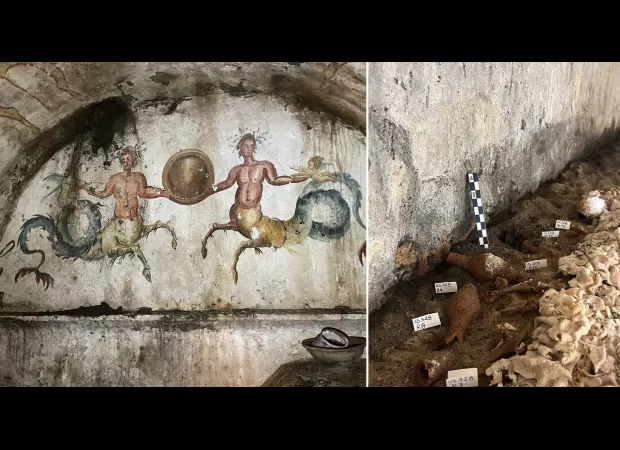Ancient mummies discovered in intact tomb by archaeologists after 2,000 years.
Corpse was preserved with plant-based lotion.

In Naples, Italy, a group of archaeologists have made an incredible discovery - well-preserved mummies! These mummies, believed to be around two thousand years old, were found in the "tomb of Cerberus," a burial site in the suburb of Giugliano in Campania. It was last year when the team uncovered this tomb, and they were astonished by what they found inside.
Upon opening the tomb, the archaeologists were met with impressive frescos on the ceiling, depicting the three-headed dog from ancient Greek mythology, Cerberus. This creature was said to guard the underworld, and it was an intriguing sight to see it depicted in such detail. But that was not the only thing that caught their attention - the mummies themselves were in remarkable condition.
It was discovered that the bodies had been preserved using plant-based creams, which were applied before the bodies were sealed. This was a common practice in Ancient Rome, and this discovery offers new and detailed evidence on how the Romans embalmed their dead. One of the mummies, believed to be the head of the family, was found covered in a shroud and surrounded by grave goods. The care taken over his preservation, along with the goods he was buried with, suggests that he was highly respected and held a prominent position in society.
The team behind the excavation, from the Superintendency of Archaeology, Fine Arts, and Landscape, are planning to release photos of the mummies at a later date. They are also conducting DNA analysis to learn more about who these people were. But this was not the only discovery made in the area - several other burial sites dating back to the Roman Republic era to the Roman Imperial Age were also found in the same vicinity.
The tomb of Cerberus, with its impressive frescos and well-preserved mummies, is not the only interesting find in this region. Just nearby, underwater archaeologists uncovered a stunning marble floor among the ruins of the sunken Roman city of Baie in the Gulf of Naples. This city, once a luxurious holiday retreat for the wealthy, now lies beneath the sea and continues to reveal its secrets to us.
But back to the tomb of Cerberus - it was found that the mummies had been preserved with a cream made from absinthium and chenopodium, a type of herb also known as goosefoot. This concoction was also found on other remains, including the body of a 17th-century bishop buried under a cathedral in Sweden. Superintendent Mariano Nuzzo stated that laboratory analyses conducted on samples from the tomb have provided valuable insight into the treatment of the deceased's body and the funerary ritual carried out, enriching our understanding of Ancient Roman customs.
To enter the chamber where the mummies were found, the team had to carefully remove the tiles covering the ceiling opening. The front wall of the tomb was made using a Roman construction technique known as opus incertum, which uses irregularly shaped and randomly placed uncut stones. This wall was sealed with a slab of tuff, a light and porous rock made of volcanic ash and other sediments.
The discovery of the tomb of Cerberus has shed new light on Ancient Roman burial practices and has provided us with a glimpse into the lives of those who were laid to rest there. It is a fascinating find, and the team behind the excavation continues to uncover more information as they conduct further analysis on the mummies and their surroundings.






